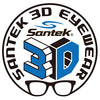Immerse yourself in the world of 3D entertainment with this comprehensive guide to understanding the key differences between linear polarized and circular polarized 3D glasses. Whether you're a curious movie-goer, a theme park enthusiast, or a business looking to invest in 3D technology, this post will unravel the science behind these intriguing devices. Let's dive into the world where glasses aren't just for vision correction, but for a whole new dimension of viewing experience.
Introduction
3D glasses are the magic portal to witnessing the awe-inspiring depth and realism that 3D movies and rides offer. These seemingly simple eyepieces play a huge role in enhancing our entertainment experiences. As advancements continue, it's essential to understand the two main types of polarization used in 3D glasses: linear and circular. What are they, how do they work, and where are they applied? This article will guide you through these critical questions.
Linear Polarized 3D Glasses
Definition and Working Principle
Linear polarized 3D glasses use filters that permit light waves aligned in particular directions to pass through. Imagine each lens as a fence with slats arranged horizontally and vertically; one lens only allows 'horizontal' light through, and the other 'vertical'. When viewing a screen that displays two overlapping images polarized at 90 degrees from one another, each eye receives a different image. This disparity replicates the way each eye views objects from slightly different angles in real life, yielding a 3D effect. We also offer an article here on how 3D works.
Benefits and Limitations
The simplicity of linear polarization makes these 3D glasses cost-effective and a great choice for passive 3D systems. However, their major limitation is the "sweet spot" for viewing. Tilting your head can disrupt the 3D effect since the alignment between the lenses and the screen changes, breaking the precise orientation required for the illusion.
Application in Cinemas and 3D Rides
Linear polarized glasses are commonly used in 3D cinemas and rides due to their affordability. They work exceptionally well in controlled environments where seat orientation is fixed, ensuring the viewer's head remains upright, maintaining the 3D effect.
Circular Polarized 3D Glasses
Definition and Working Principle
Circular polarized 3D glasses, on the other hand, take sophistication to the next level. Each lens allows light waves that rotate in a certain direction (clockwise or counterclockwise) to pass through. Unlike their linear counterparts, these glasses don't require you to maintain a fixed head position. Your head can tilt freely, and the 3D effect remains intact, thanks to the circular polarization technology.
Benefits and Limitations
Circular polarized 3D glasses bring an enhanced viewing experience with more freedom of movement. They're perfect for dynamic environments such as home theaters or 3D rides where head movement is more likely. The downside is that they may be more expensive than linear polarized glasses due to their complex manufacturing process.
Application in Cinemas and 3D Rides
In modern 3D cinemas and particularly in 3D rides, where motion is a part of the experience, circular polarized glasses are often the standard. They ensure that the immersion remains unbroken, no matter how much the viewer moves.
Comparison and Contrast
The core differentiation between the two types lies in the viewer's ability to maintain the 3D effect irrespective of head position. Linear polarized glasses demand an upright, static position while circular polarized glasses allow for movement. When choosing the most appropriate glasses, consider the environment they will be used in and the level of comfort and freedom of movement you desire during the 3D experience.
Conclusion
At the end of the day, both linear and circular polarized 3D glasses have their place in the growing 3D market. Understanding the nuances between them is not just academic; it's a practical consideration that impacts your enjoyment of 3D content. Whether you are a consumer wanting the best 3D movie experience or a business deciding on which technology to invest in for your 3D offerings, recognizing these differences is key. As you step out, glasses in hand, ready to explore three-dimensional ventures, remember that the right pair isn't just an accessory—it's the gateway to a realm of extraordinary visual depth.
Here are our series of Polarized 3D glasses suitable for 3D cinemas and rides.
・Polarized 3D Eyewear - Plastic Frame(Foldable Type)
・Polarized 3D Eyewear - Plastic Frame (Unfoldable Type)
・Polarized 3D Eyewear - Normal Size Paper type
・Polarized 3D Eyewear - Kid's Size Paper type
・Polarized 3D Eyewear - Clip-on Type
About Santek 3D Eyewear
San Technology, Inc. has opened a specialized 3D Eyewear sales site, "Santek 3D Eyewear." We offer various types of 3D glasses with various frames (plastic, paper, clip-on) and a diverse selection of Eyewear. We accept small quantity purchases starting from one item, bulk orders of 500 pieces or more, and also offer customization for frames. We accommodate various needs, including color, frame design, shape, and the design of packaging bags.
Important Note
Currently, our direct shopping page is designed for orders from Japan. However, we welcome orders from customers outside of Japan. Please submit a direct inquiry using the form below or send an email to s.shop@santek3d.jp .
・Our Products
・Inquiry Form for inquiries about bulk orders, customizations, and more
Since 2006, San Technology, Inc. has supplied over 1 billion 3D eyewears and glasses to over 20 countries worldwide. We believe that we are providing the highest-quality products in the world.
・San Technology, Inc. Website
・Other Shop Links for customers in Japan
Santek 3D Eyewear Amazon Store
Santek 3D Eyewear Rakuten Shop
・Please follow us on social media
Facebook Instagram X




